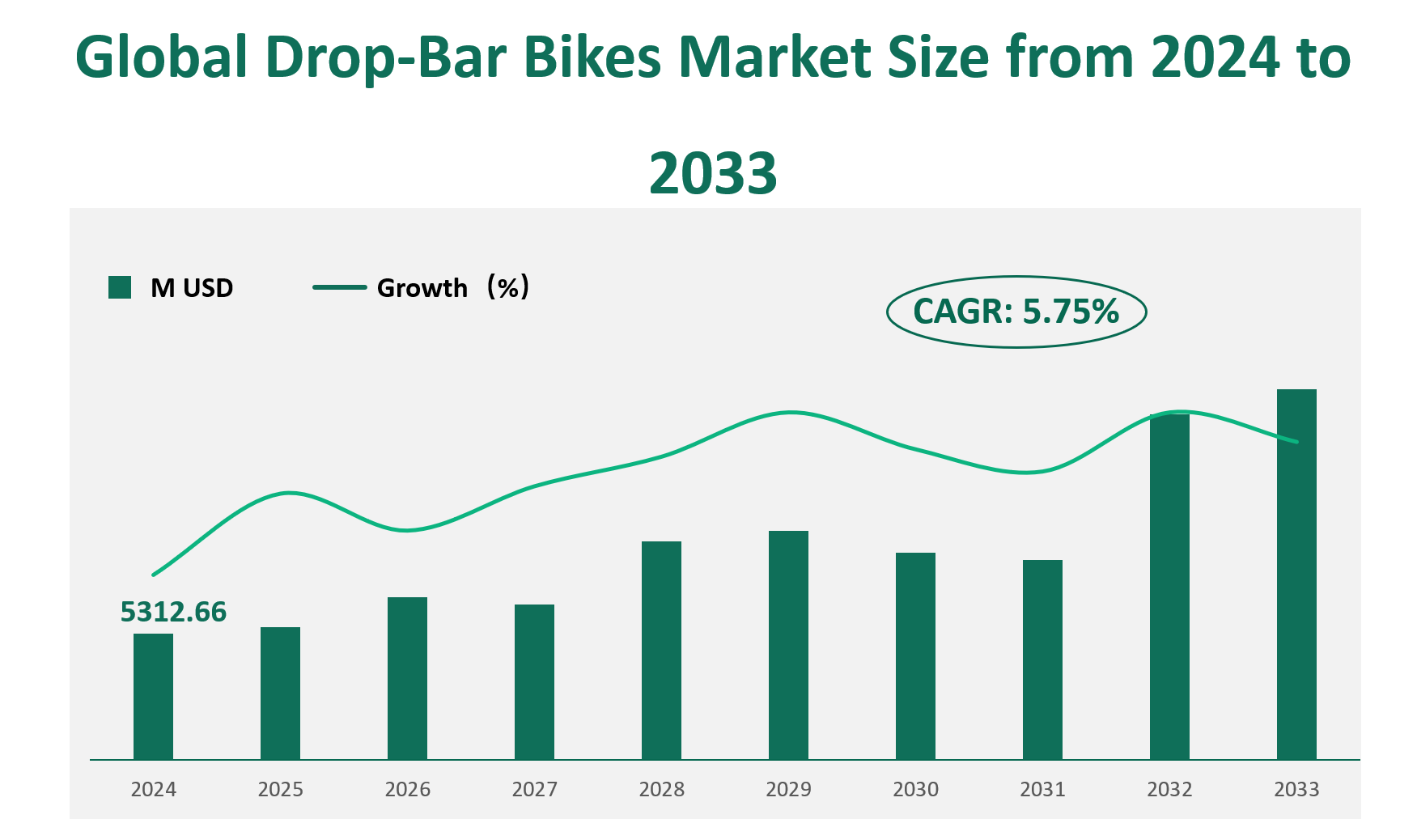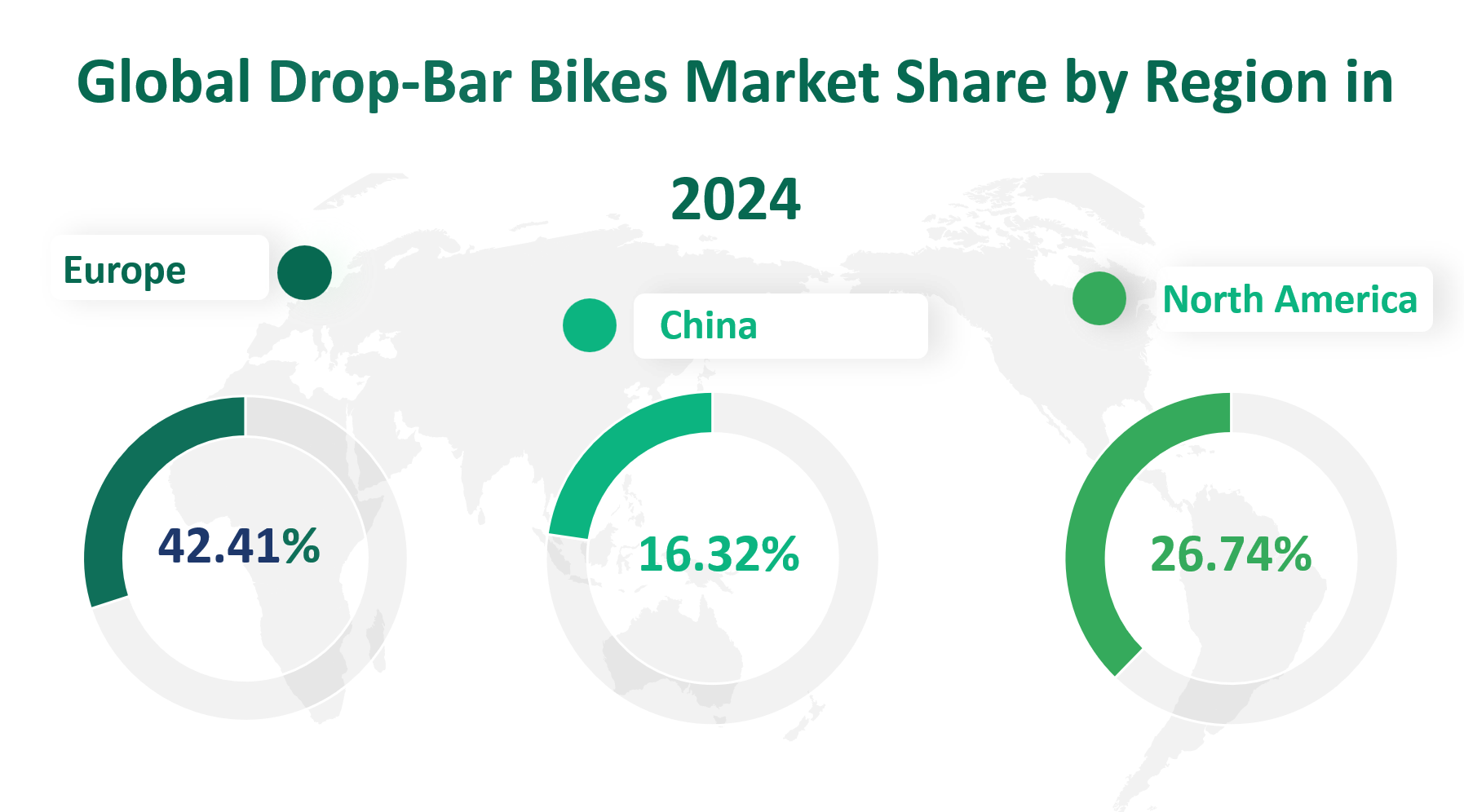1. Global Drop-Bar Bikes Market Outlook
The global Drop-Bar Bikes market is projected to reach a revenue of 5312.66 million USD in 2024, with a Compound Annual Growth Rate (CAGR) of 5.75% from 2024 to 2033.
Drop-Bar Bikes, also known as road bikes or racing bikes, are characterized by their drop-shaped handlebars, which provide multiple hand positions for the rider. This design not only enhances comfort during long rides but also offers aerodynamic advantages, making them popular among both casual riders and professional cyclists.
Figure Global Drop-Bar Bikes Market Size (M USD) and CAGR (2024-2033)

2. Driving and Limiting Factors of Drop-Bar Bikes Market Growth
The growth of the Drop-Bar Bikes market is driven by several key factors. Firstly, the increasing demand for environmentally friendly transportation has led consumers to seek out bicycles as a sustainable alternative to motor vehicles. Governments and international organizations are setting strict emission standards, prompting a shift towards cleaner transportation options. Additionally, the COVID-19 pandemic has significantly boosted the demand for bicycles, as people avoid public transportation and seek outdoor activities for health and fitness. The growing popularity of cycling races and adventure sports has also contributed to the market’s expansion, with events like the Tour de France increasing the visibility and appeal of Drop-Bar Bikes.
However, the market also faces certain challenges. One of the main limiting factors is the performance shortcomings of Drop-Bar Bikes, which are less suitable for short-distance commuting and may be less powerful at slow speeds compared to flat-bar bicycles. The design of the handlebars also limits the space for accessories and can be less comfortable for riders in casual or formal clothing. Technological challenges, particularly in the electric bike segment, such as controlling motor speed and torque and optimizing battery capacity, also pose constraints. Furthermore, international trade policies and regulations, such as anti-dumping policies in Europe and the Sino-US trade war, have affected the market by disrupting the supply of bicycle parts and increasing market uncertainty.
3. Technology Innovation and Corporate Mergers and Acquisitions in Drop-Bar Bikes Market
Innovation in the Drop-Bar Bikes market is a significant driver of growth. Product innovation includes the integration of batteries and drives, the use of high-quality materials, and the development of attractive designs. Features such as automatic speed control and anti-theft functions are becoming more prevalent, enhancing the appeal of these bikes as sports and high-performance vehicles. The introduction of full-size folding Drop-Bar Bikes is also a trend, offering convenience for travel and adventure.
Corporate mergers and acquisitions have played a crucial role in shaping the market. For example, Trek Bicycle’s acquisition of Bike UK in 2019 strengthened its market position by expanding its retail network. Merida’s investment of 18 million euros in European electric bicycle production in 2019 demonstrates the industry’s focus on expanding production capabilities to meet the growing demand for e-bikes. Accell Group’s successful acquisition of Velosophy in 2018 accelerated its innovation strategy, particularly in urban mobility solutions. These strategic moves by key players indicate a trend towards consolidation and expansion in the market, aiming to enhance competitive advantage and market share.
4. Global Drop-Bar Bikes Market Size by Type
Drop-bar bikes are a category of bicycles designed for various riding conditions and purposes. They are characterized by their drop-shaped handlebars, which offer multiple hand positions for comfort and control. The market for drop-bar bikes is segmented into four main product types: Road, Gravel, eRoad, and eGravel.
Road Bikes are designed for speed and efficiency on paved roads. They feature narrow tires, high-pressure and smooth tires to reduce rolling resistance. Road bikes are the most traditional form of drop-bar bikes and are used for racing, training, and commuting. In 2024, the market revenue for Road bikes is forecasted to be $3,040.83 million. Road bikes have traditionally held the largest market share due to their versatility and the popularity of road cycling.
Gravel Bikes are a more recent development in the cycling world. They are designed to handle a variety of terrains, including off-road, gravel, dirt, and fire roads. Gravel bikes have a longer wheelbase, lower bottom bracket, and looser head tube angle, which provides stability on loose surfaces and during long-distance rides. The market revenue for Gravel bikes in 2024 is projected to be $1475.86 million. Gravel bikes have been gaining popularity due to the growing interest in adventure cycling and the desire for bikes that can handle more than just paved roads.
eRoad Bikes are electric-assist road bikes. They are equipped with bottom bracket motors that provide pedal assistance, converting battery energy into pedaling help, thus allowing for faster riding speeds. eRoad bikes are ideal for those who want the speed and efficiency of a road bike with a little extra help from the motor. The market revenue for eRoad bikes in 2024 is expected to be $500.46 million.
eGravel Bikes are the electric version of gravel bikes. They combine the off-road capabilities of gravel bikes with the motor assistance of e-bikes. eGravel bikes are perfect for those who want to explore more challenging terrains or for those who need a little extra power to tackle long rides. The market revenue for eGravel bikes in 2024 is forecasted to be $295.52 million. eGravel bikes are a relatively new segment but are growing rapidly due to the combination of adventure and electric assistance.
Table Global Drop-Bar Bikes Market Size by Type in 2024
|
Market Size (M USD) 2024 |
Market Share | |
|
Road |
3040.83 |
57.24% |
|
Gravel |
1475.86 |
27.78% |
|
eRoad |
500.46 |
9.42% |
|
eGravel |
295.52 |
5.56% |
5. Global Drop-Bar Bikes Market Size by Price Range
The Drop-Bar Bikes market is segmented into three primary price ranges: Below €1000, From €1000 to €4000, and Over €4000.
Bikes in Below €1000 price range are typically entry-level models, designed for beginners or casual riders. They are suitable for daily commuting, light training, or recreational riding. These bikes are known for their affordability and basic functionality, often featuring lower-end components and materials. The focus is on providing a reliable and cost-effective option for those new to cycling or looking for a secondary bike.
The Below €1000 segment is projected to generate a revenue of $3436.83 million USD in 2024. This price range holds the largest market share, accounting for 64.69% of the total market revenue in 2024. The dominance of this segment can be attributed to its broad appeal to a wide range of consumers, including beginners, budget-conscious riders, and those who use bikes for occasional leisure rides.
Bikes in From €1000 to €4000 price range are designed for more serious riders who require better performance and features. These bikes often have mid-range components, such as aluminum frames, hydraulic disc brakes, and higher-quality drivetrains. They are suitable for endurance riding, racing, and more demanding terrains. The focus is on achieving a balance between performance, comfort, and value for money.
The From €1000 to €4000 segment is expected to generate a revenue of $1421.52 million USD in 2024. This segment holds a market share of 26.76% in 2024, making it the second-largest in terms of revenue. The market share reflects the significant demand for bikes that offer a step-up in performance and features, catering to enthusiasts and semi-professional riders.
Bikes in Over €4000 price range are high-end, professional-grade models, designed for serious racers and performance-oriented riders. These bikes feature top-of-the-line components, such as carbon fiber frames, electronic shifting systems, and advanced aerodynamic designs. They are built for speed, agility, and the highest level of performance, making them suitable for professional racing, high-intensity training, and demanding adventures. The focus is on providing the best possible riding experience and competitive advantage.
The Over €4000 segment is projected to generate a revenue of $454.32 million USD in 2024. This segment holds the smallest market share, accounting for 8.55% of the total market revenue in 2024. Despite its smaller share, the Over €4000 segment represents the pinnacle of Drop-Bar Bikes technology and performance, catering to a niche market of professional cyclists and serious enthusiasts.
Table Global Drop-Bar Bikes Market Size by Price Range in 2024
|
Price Range |
Market Size (M USD) 2024 |
Market Share |
|
Below €1000 |
3436.83 |
64.69% |
|
From €1000 to €4000 |
1421.52 |
26.76% |
|
Over €4000 |
454.32 |
8.55% |
|
Total |
5312.66 |
100.00% |
6. Major Region of Drop-Bar Bikes Market
North America has historically been a strong market for drop-bar bikes, driven by a robust cycling culture, a focus on health and fitness, and a well-developed infrastructure for cycling. In 2024, the revenue from drop-bar bikes in North America is forecasted to be $1,420.85 million.
Europe is a significant player in the global drop-bar bikes market, with a deep-rooted cycling tradition and a strong emphasis on cycling as a mode of transportation and recreation. In 2024, the revenue from drop-bar bikes in Europe is expected to reach $2,253.20 million, making it the largest regional market by revenue.
The China region is a rapidly growing market for drop-bar bikes, driven by the increasing disposable income of consumers, a growing middle class, and a rising interest in cycling as a sport and leisure activity. In 2024, the revenue from drop-bar bikes in the China region is forecasted to be $866.79 million. China.
Figure Global Drop-Bar Bikes Market Size by Region in 2024

7. Global Drop-Bar Bikes Market Analysis by Major Players
7.1 Giant
Company Introduction and Business Overview:
Giant is the world’s leading high-quality bicycle and cycling equipment brand, part of the Giant Group. Founded in 1972, Giant combines craftsmanship, technology, and innovative design to offer a complete ecosystem of bicycles, equipment, and services. The company’s manufacturing plants are mainly located in Asia, Europe, and North America, with sales regions spanning the globe.
Products Offered:
Giant offers a wide range of Drop-Bar Bikes, including road bikes, gravel bikes, and e-bikes. Notable models include the TCR ADV SL 0 DISC, known for its top efficiency, aerodynamics, and full control features.
7.2 Accell Group
Company Introduction and Business Overview:
Accell Group, founded in 1998, is a leading producer of bicycles, bicycle parts, and accessories. The company is the leader in the European electric bicycle market and the second-largest market for bicycle parts and accessories. Accell Group’s product portfolio includes well-known brands such as Haibike, Winora, Ghost, and Batavus.
Products Offered:
Accell Group offers a variety of Drop-Bar Bikes, including road bikes and gravel bikes. Notable models include the KIMERA PRIME DKK 43999, which features a 2 x 12-speed wireless transmission system and a lightweight carbon fiber frame.
7.3 Trek
Company Introduction and Business Overview:
Trek, founded in 1976, is a renowned American bicycle manufacturer. The company’s bicycles have been used by professional riders in well-known races for many years. Trek is known for its innovation and commitment to creating high-performance bikes.
Products Offered:
Trek offers a diverse range of Drop-Bar Bikes, including road bikes, gravel bikes, and e-bikes. Notable models include the Checkpoint, designed for versatility and long-distance riding.

